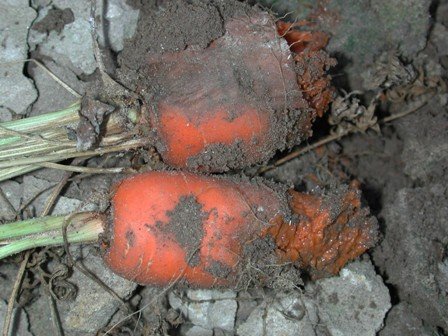(Erwinia carotovora var. carotovora)
Credits: Biovision-Infonet

(c) Oregon State University
Erwinia carotovora subsp. carotovora is a bacterium. Bacteria survive in decaying refuse and enter the root principally through cultivation wounds, harvest bruises, freezing injury, and insect openings.
After infection, high humidity is essential for progress of the disease.
When soft rot occurs in the field, it usually follows a period of water logging in low areas following excessive rain or irrigation.
Carrots, potatoes, onions, crucifers, and celery are only a few of the many plants attacked.
The disease causes a soft, watery, slimy rot. The rotted tissues are grey to brown and may have a foul odour.
It decays the core of the root. Also prolonged wet weather favours disease development.
It is a serious transit and storage problem if affected carrots are not discarded.
In the field, tops of rotted carrots turn yellow and wilt as roots break down.
What to do:
- Follow a crop rotation of cereals and fodder grasses.
- Destroy by burning of infected plants.
- Carefully handle carrots at harvesting to minimise bruising.
- Discard affected carrots before transport and storage.
- Store carrots in well ventilated places.